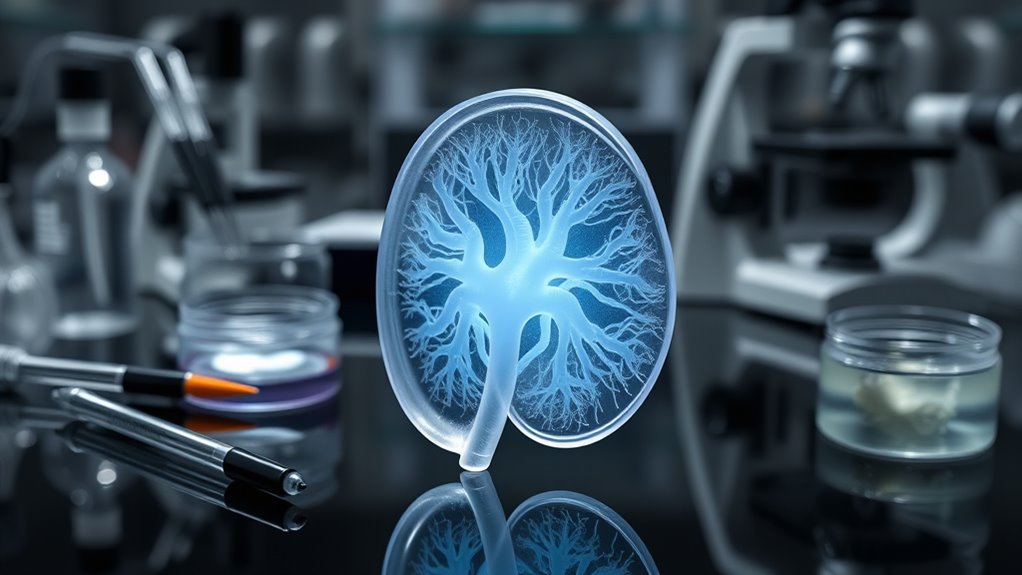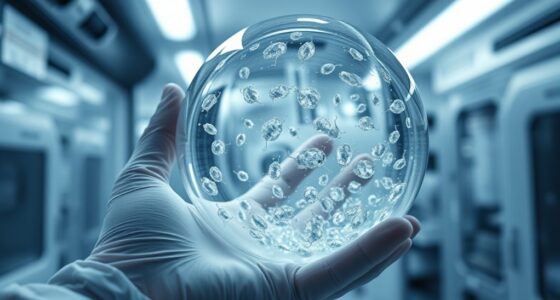Scientists have successfully 3D-printed a tiny human kidney that can produce urine in a lab setting. This breakthrough marks a significant step in regenerative medicine, showing progress toward creating fully functional organs for transplant. While challenges remain, such as ensuring blood vessel formation and tissue health, this achievement provides hope for future organ replacements. Keep exploring to discover how this advancement could impact medicine and address organ shortages.
Key Takeaways
- Scientists successfully 3D-printed a miniature human kidney capable of producing urine in the lab.
- The breakthrough advances organ replacement research and offers potential for drug testing and disease study.
- The bioprinted kidney demonstrates functional capability, including urine generation, indicating progress toward full organ functionality.
- Challenges remain in developing vascularized, complex tissues with precise cell placement for clinical application.
- Ethical considerations and technical hurdles must be addressed before bioprinted kidneys can be used for transplantation.

Scientists have successfully developed a miniature human kidney using 3D printing technology, marking a significant breakthrough in regenerative medicine. This achievement opens new possibilities for organ replacement, drug testing, and understanding kidney diseases. However, as groundbreaking as it is, you should be aware of the hurdles that come with bioprinting such complex organs. One major challenge is bioprinting challenges, which involve creating a functional, vascularized tissue that can mimic the natural kidney’s intricate structure. Achieving the right cell placement, ensuring proper blood vessel formation, and maintaining tissue viability during and after printing are significant obstacles. These technical hurdles require advanced biomaterials and precise control over the printing process, making the journey from lab success to clinical application quite lengthy.
Alongside these scientific challenges, ethical considerations also come into play. You might wonder about the implications of creating lab-grown organs, especially when it involves manipulating human cells and tissues. Ethical concerns revolve around the source of the cells used, consent processes, and potential misuse of bioprinted organs. As the technology advances, questions about accessibility and equity also emerge—who gets access to these organs, and how do we prevent disparities in healthcare? The possibility of printing organs raises debates about identity, consciousness, and the boundaries of human enhancement. It’s essential for scientists, policymakers, and society to navigate these moral dilemmas carefully, establishing guidelines to guarantee responsible development and deployment.
Despite these challenges, the progress achieved signifies a leap toward solving organ shortages and reducing transplant rejection risks. The miniature kidney produced in labs can now generate urine, proving its functional potential. This success demonstrates that, with continued research, you could someday see fully functional, bioprinted kidneys used in transplants, alleviating millions of patients suffering from kidney failure. Yet, it’s vital to remain cautious. The road ahead involves refining bioprinting techniques, ensuring safety, and addressing ethical concerns to build public trust. As the science evolves, you should stay informed about ongoing discussions surrounding regulation, consent, and the moral implications of creating human organs in the lab.
Frequently Asked Questions
How Long Does It Take to 3d-Print a Mini Human Kidney?
You might wonder how long it takes to 3D-print a mini human kidney. The bioprinting speed and complexity of the design influence the fabrication timeline. Generally, it can take anywhere from a few hours to several days, depending on the detail and size of the organ. Faster bioprinting techniques help minimize production time, but intricate structures still require careful, step-by-step processes to ensure functionality and safety.
Can These Lab-Grown Kidneys Fully Replace Natural Kidneys?
You wonder if lab-grown kidneys can fully replace natural ones. While organ viability shows promise, these mini kidneys still face hurdles before they can take over. Ethical implications also arise about replacing natural organs with lab-made ones. Right now, they’re not ready for complete replacement, but ongoing advancements could someday make this possible. For now, they’re valuable tools for research and treatment, not total substitutes.
What Materials Are Used in the 3d-Printing Process?
You should know that in bioprinting, bioinks are essential—they contain living cells and are used to build tissues. Scaffold materials, like biocompatible hydrogels, provide support for cell growth and structure. These materials work together during 3D printing to create complex organs like kidneys, ensuring they mimic natural tissue functions. By combining bioinks and scaffold materials, scientists can accurately reproduce the intricate architecture of human organs.
Are There Any Ethical Concerns With Printing Human Organs?
When considering ethical concerns, you should think about informed consent, organ commodification, and equitable access. You might worry about whether donors truly agree, if organs become commodities, or if only the wealthy can benefit. These issues create complex dilemmas that challenge fairness and autonomy. As you explore organ printing, it’s essential to balance technological advances with ethical responsibilities, ensuring respect for human dignity and equitable treatment for all.
How Close Are These Kidneys to Clinical Application?
You’re wondering how close these 3D-printed kidneys are to clinical use. While significant progress is made in regenerative medicine, it still takes time to guarantee safety and functionality for organ transplantation. Researchers are refining these bioengineered organs, but widespread clinical application isn’t immediate. You can expect more testing and development before they become a viable option for patients needing kidney transplants, marking a promising step forward in organ regeneration.
Conclusion
You can see that this breakthrough is a game-changer in medical science. With 3D printing, you’re not just dreaming of better organ transplants; you’re making it happen. This mini human kidney producing urine in the lab is proof that where there’s a will, there’s a way. Keep an eye on this technology—it’s paving the path to a future where organ shortages might be a thing of the past. The sky’s the limit when innovation leads the charge.









